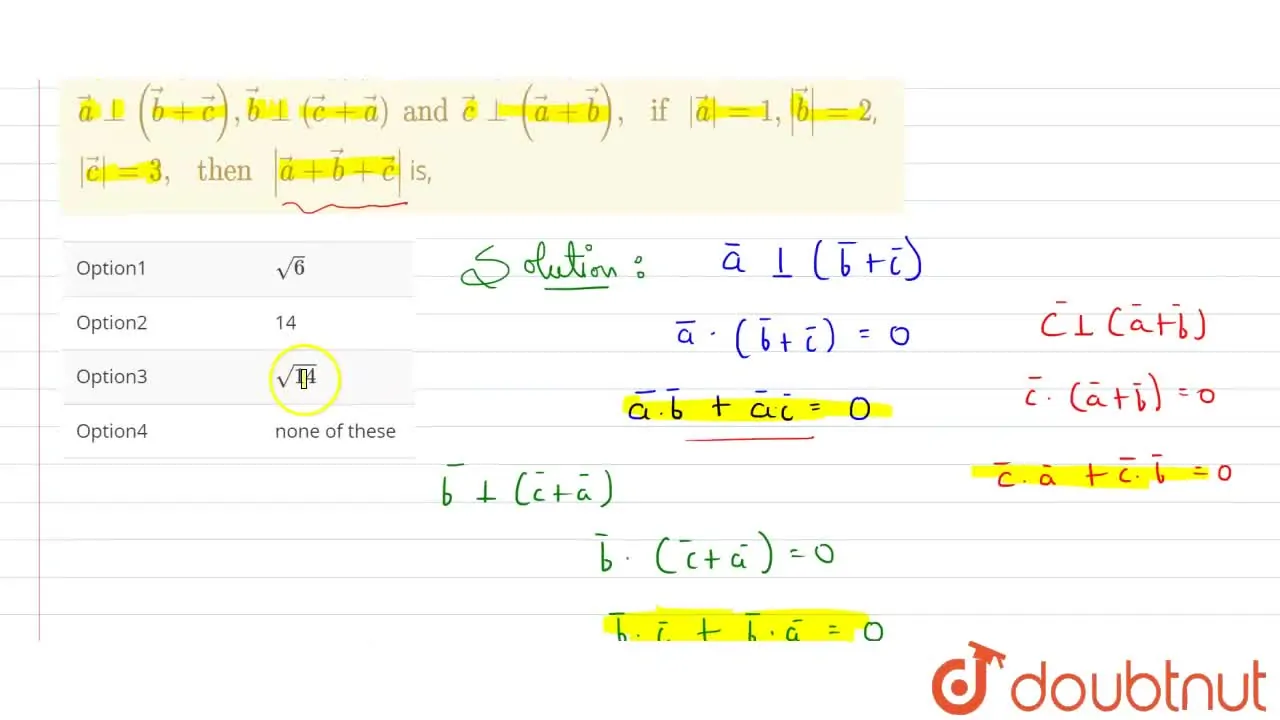Let →a,→b,→c be three vectors such that
→a⊥(→b+→c),→b⊥(→c+→a)and→c⊥(→a+→b), if |→a|=1,∣∣→b∣∣=2,
|→c|=3, then ∣∣→a+→b+→c∣∣ is,
√6
14
√14
none of these
The correct Answer is:C
we have,
→a⊥(→b+→c),→b⊥(→c+→a)and→c⊥(→a+→b)
⇒→a.→b+→a.→c=0,→b.→a=0,→c.→a+→c.→b=0
⇒→a.→b=→b.→c=→c.→a=0
∣∣→a+→b+→c∣∣2=|→a|2+2(→a.→b+→b.→c+→c.→a)
⇒∣∣→a+→b+→c∣∣2=1+4+9=14
⇒∣∣→a+→b+→c∣∣=√14
Related Playlists
- BOOK - OBJECTIVE RD SHARMA ENGLISHCHAPTER - SCALER AND VECTOR PRODUCTS OF TWO VECTORS EXERCISE - Section I - Solved Mcqs12videos
SCALER AND VECTOR PRODUCTS OF TWO VECTORS
- BOOK - OBJECTIVE RD SHARMA ENGLISHCHAPTER - SCALAR AND VECTOR PRODUCTS OF THREE VECTORS EXERCISE - Exercise63videos
SCALAR AND VECTOR PRODUCTS OF THREE VECTORS
- BOOK - OBJECTIVE RD SHARMA ENGLISHCHAPTER - SOLUTIONS OF TRIANGLES EXERCISE - Exercise20videos
SOLUTIONS OF TRIANGLES
Similar Questions
if →a,→b,→c are three vectors such that →a+→b+→c=→0 then
View SolutionIf |→a|=4,∣∣→b∣∣=4 and |→c|=5 such that →a⊥→b+→c,→b⊥(→c+→a) and →c⊥(→a+→b), then ∣∣→a+→b+→c∣∣ is:
View SolutionIf →a,→b,→c are vectors such that →a.→b=0 and →a+→b=→c then:
View SolutionIf →a,→band→c are three vectors such that →a×→b=→c,→b×→c=→a,→c×→a=→b then prove that |→a|=∣∣→b∣∣=|→c|
View SolutionIf →a,→b,→c are three non-coplanar vectors such that →a×→b=→c,→b×→c=→a,→c×→a=→b, then the value of |→a|+∣∣→b∣∣+|→c| is
View SolutionIf →a,→b,→c are three non-zero vectors such that →a+→b+→c=0 and m=→a.→b+→b.→c+→c.→a, then:
View Solution[→a+→b→b+→c→c+→a]=[→a→b→c], then
View SolutionIf →a,→b,→c are any three vectors such that (→a+→b).→c=(→a−→b)→c=0 then(→a×→b)×→c is
View SolutionIf →a,→b,→care unit vectors such that →a+→b+→c=→0 find the value of (→a⋅→b+→b⋅→c+→c⋅→a).
View SolutionLet →a,→b,→c be three unit vectors such that angle between →aand→bisα,→band→c is βand→cand→a is γ. if ∣∣→a.+→b+→c∣∣=2 , then cosα+cosβ+cosγ =
View Solution


